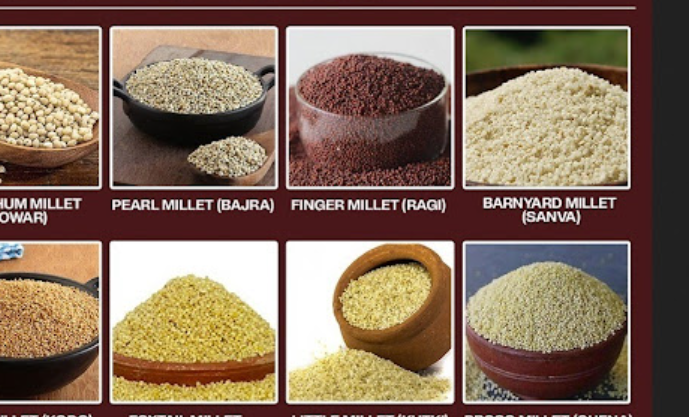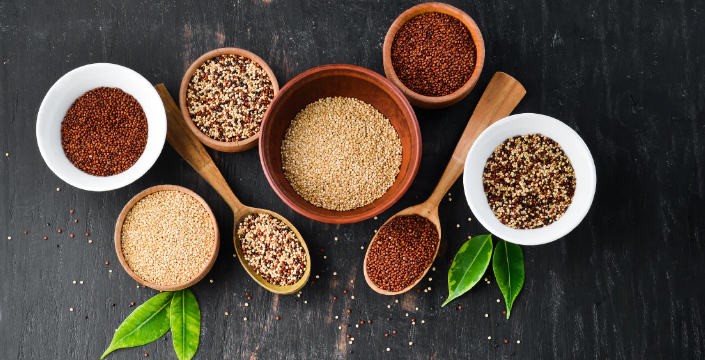Millets
Finger Millet (Ragi)
uses, benefits, and nutritional values of finger millet (also known as ragi):
What Is Finger Millet?
Finger millet, scientifically known as Eleusine coracana, is an ancient cereal grain that has been a dietary staple across Africa and Asia for thousands of years. These round, reddish-brown grains thrive in hot, semi-arid climates and are packed with essential nutrients. Let’s dive into the details:
Nutritional Value (Per 100g)
- Energy: 320 kcal
- Dietary Fiber: 11.18g
- Carbohydrates: 66.82g
- Total Fat: 1.92g
- Protein: 7.16g
- Total Folates: 34.66mcg
- Vitamin B1 (Thiamin): 0.37mg
- Vitamin B2 (Riboflavin): 0.17mg
- Vitamin B6 (Pyridoxine): 0.05mg
- Vitamin K: 0.9mcg
- Phosphorus: 210mg
- Manganese: 3.19mg
- Potassium: 443mg
- Zinc: 2.53mg
- Calcium: 364mg
- Iron: 4.62mg
- Magnesium: 146mg
Benefits of Finger Millet:
- High Protein Content:
- Finger millet contains 2g of protein per 100g, similar to rice. Some varieties have even higher protein levels, up to 14.7g per 100g.
- Bone Health:
- Rich in calcium, finger millet strengthens bones, especially in growing children and the elderly. Regular consumption helps prevent osteoporosis and reduces fracture risk.
- Antioxidants and Nutraceuticals:
- Finger millet contains polyphenols, tannins, and phytates, which have anti-aging properties and relax muscles and nerves. It also aids in anxiety, depression, and sleep disorders.
- Nourishing and Versatile:
- Finger millet can be ground into flour for breads, porridges, soups, and even beer. It forms part of cherished food traditions across cultures.
- Food Security:
- This hardy grain could play a key role in strengthening food security for vulnerable farming communities worldwide.
Incorporate finger millet into your diet for its health benefits and culinary versatility.
Wheat Flour (A Nutrient-Packed Staple): uses, benefits, and nutritional values of wheat flour:
Wheat flour, derived from the cereal grain Triticum, is a versatile ingredient used in various culinary applications. It comes in different forms, including whole wheat flour and refined white flour. Here’s what you need to know:
- Nutritional Value (Whole-Grain Wheat Flour per 100g):
- Calories: 340
- Water: 11%
- Protein: 13.2g
- Carbohydrates: 72g
- Sugar: 0.4g
- Fiber: 10.7g
- Fat: 2.5g
- Carbohydrates:
- Wheat is primarily composed of carbs, with starch being the predominant type. However, both white and whole wheat have a high glycemic index (GI), which may impact blood sugar levels, especially for individuals with diabetes.
- Fiber:
- Whole wheat flouris rich in fiber, contributing to gut health. Unfortunately, refined flour lacks most of this fiber due to the removal of bran during milling.
- Antioxidants and Vitamins:
- Whole-grain wheat contains antioxidants, vitamins (such as B-1, B-3, and B-5), and minerals. These nutrients support overall health.
- Iron and Calcium:
- Whole wheat flour provides more ironand calcium compared to white flour.
- Protein:
- Wheat flour contains moderate amounts of protein, essential for tissue repair and overall body function.
- Versatility:
- Wheat flour is a key ingredient in baked goods like bread, pasta, noodles, semolina, bulgur, and couscous.
- Caveat: Gluten Content:
Wheat products contain gluten, which can trigger immune responses in sensitive individuals. People with celiac disease or gluten intolerance should choose alternative







Foxtail Mille:
uses, benefits, and nutritional values of foxtail millet:
Nutritional Value of Foxtail Millet (Per 100g):
- Calories: 320 kcal
- Protein: 13.2g
- Carbohydrates: 72g
- Dietary Fiber: 10.7g
- Fat: 2.5g
- Vitamin B12: Rich source
- Calcium: Abundant
- Iron: Significant
- Lysine, Thiamine, and Niacin: Copious amounts
Health Benefits of Foxtail Millet:
- Rich in Protein:
- Foxtail millet provides ample protein, essential for tissue repair and overall health.
- Dietary Fiber:
- Its high fiber contentaids digestion, promotes gut health, and helps manage weight.
- Vitamin B12:
- Foxtail millet is a rich source of vitamin B12, crucial for energy production and nerve function.
- Minerals:
- It offers abundant calciumand significant iron, supporting bone health and preventing anemia.
- Gluten-Free:
- Being gluten-free, it suits individuals with gluten intolerance.
- Low Glycemic Index:
- Foxtail millet is a good choice for managing blood sugar levels due to its low glycemic index.
Incorporate foxtail millet into your diet for its health benefits and versatility.
Sorghum Millet : uses, benefits, and nutritional values of sorghum millet:
Nutritional Value of Sorghum Millet (Per 100g):
- Calories: 329
- Protein: 13.2g
- Carbohydrates: 72g
- Dietary Fiber: 10.7g
- Fat: 2.5g
- Vitamin B12: Rich source
- Calcium: Abundant
- Iron: Significant
- Lysine, Thiamine, and Niacin: Copious amounts
Health Benefits of Sorghum Millet:
- Rich in Protein:
- Sorghum millet provides ample protein, essential for tissue repair and overall health.
- Dietary Fiber:
- Its high fiber contentaids digestion, promotes gut health, and helps manage weight.
- Vitamin B12:
- Sorghum is a rich source of vitamin B12, crucial for energy production and nerve function.
- Minerals:
- It offers abundant calciumand significant iron, supporting bone health and preventing anemia.
- Antioxidants:
- Sorghum contains antioxidants that reduce oxidative stress and inflammation in blood vessels.
- Low Glycemic Index:
- Sorghum is a good choice for managing blood sugar levels due to its low glycemic index.
Incorporate sorghum millet into your diet for its health benefits and versatility.
Pearl Millet (Bajra): uses, benefits, and nutritional values of pearl millet (also known as bajra):
What Is Pearl Millet (Bajra)?
Pearl millet, scientifically known as Pennisetum glaucum, is a hardy cereal grain that thrives in arid regions. It has been a staple food in Africa and India for centuries. The edible seeds of pearl millet come in various shades of white, yellow, gray, brown, and bluish-purple. They are typically cooked as a cereal grain or ground into flour.
Nutritional Value (Per 100g of Cooked Millet):
- Calories: 201
- Protein: 6 grams
- Fat: 1.7 grams
- Carbohydrates: 40 grams
- Dietary Fiber: 2 grams
- Sodium: 286 mg
- Folate: 8% of the Daily Value (DV)
- Iron: 6% of the DV
- Magnesium: 18% of the DV
- Thiamine (Vitamin B1): 15% of the DV
- Niacin: 14% of the DV
- Phosphorus: 14% of the DV
- Zinc: 14% of the DV
- Riboflavin (Vitamin B2): 11% of the DV
- Vitamin B6: 11% of the DV
Health Benefits of Pearl Millet (Bajra):
- Digestive Health:
- Pearl millet is rich in dietary fiber, aiding digestion and promoting a healthy gut.
- Heart Health:
- It supports heart health by regulating blood sugar levelsand reducing the risk of cardiovascular diseases.
- Nutrient-Dense:
- Pearl millet is a good source of vitamins and minerals, including iron, magnesium, and B vitamins.
- Weight Management:
- Its low-calorie density makes it suitable for weight loss diets.
- Gluten-Free:
Bajra is gluten-free, making it safe for those with celiac disease or gluten intolerance.
- Antioxidants:
- Pearl millet contains beneficial plant chemicals, contributing to overall well-being.
Incorporate pearl millet into your diet for its health benefits and versatility.
Panicum Miliaceum : uses, benefits, and nutritional values of proso millet (also known as Panicum miliaceum):
Nutritional Value of Proso Millet (Per 100g):
- Calories: 350 kcal
- Protein: 11.6g
- Carbohydrates: 71.5g
- Dietary Fiber: Comparable to oats
- Vitamins: Thiamine, riboflavin, niacin, pyridoxine, and Vitamin E
- Minerals: Phosphorus, manganese, iron, and potassium
- Bioactive Compounds: Polyphenols
Health Benefits of Proso Millet:
- High-Quality Protein:
- Proso millet provides essential amino acids like leucine, isoleucine, and methionine, making it a high-quality protein source.
- Heart and Liver Health:
- It may have beneficial effects on heart health by increasing adiponectin levels and improving lipid profiles.
- Type 2 Diabetes Management:
- Proso millet consumption has been associated with elevated adiponectin levels and improved glucose and insulin regulation.
- Gluten-Free Option:
- Being gluten-free, it suits individuals with gluten intolerance.
- Antioxidants and Nutraceuticals:
- Proso millet contains polyphenolsand other bioactive compounds with nutritional importance.
Incorporate proso millet into your diet for its health benefits and versatility.
Fonio Millet : uses, benefits, and nutritional values of fonio millet:
What Is Fonio Millet?
Fonio millet (Digitaria exilis and Digitaria iburua) is an ancient African heritage grain that holds significant cultural importance. It’s considered one of the continent’s oldest cultivated cereals and has been a staple in West African countries like Senegal, Burkina Faso, Mali, Togo, and Nigeria. Here’s what you need to know:
Nutritional Value (Per 100g of Dry Fonio):
- Calories: 170
- Protein: 2g
- Carbohydrates: 39g
- Dietary Fiber: 1g
- Vitamins: Thiamine (B1), riboflavin (B2), niacin, and vitamin E
- Minerals: Phosphorus, manganese, iron, and zinc
- Bioactive Compounds: Polyphenols
Health Benefits of Fonio Millet:
- Nutrient-Dense:
- Fonio is naturally low in cholesterol, sodium, and fat, making it a nutritious choice.
- Rich in B Vitamins:
- It supplies essential B vitamins like thiamine (B1), riboflavin (B2), and niacin.
- Mineral Content:
- Fonio provides abundant phosphorus, manganese, iron, and zinc.
- Gluten-Free and Vegan:
- It’s naturally gluten-free and suitable for vegan diets.
- Cultural Significance:
- Fonio has sociocultural importance in West African ceremonies and traditions.
Brown Top Millet : uses, benefits, and nutritional values of brown top millet:
Brown Top Millet: A Nutrient-Packed Grain
Brown top millet (Urochloa ramosa), also known as koralee in Kannada, is a lesser-known millet variety that offers several health benefits. Here’s what you need to know:
Nutritional Value (Per 100g):
- Protein: 11.5g
- Dietary Fiber: 12.5g
- Minerals: 4.2g iron, 0.65g calcium
- Other Nutrients: Trace amounts of magnesium, phosphorus, and zinc
Health Benefits of Brown Top Millet:
- Rich in Protein:
- Brown top millet provides essential amino acids and is a good source of plant-based protein.
- Dietary Fiber:
- Its high fiber content aids digestion, promotes gut health, and helps manage weight.
- Mineral Content:
- Brown top millet is rich in iron, calcium, and other essential minerals.
- Gluten-Free Option:
- Being gluten-free, it suits individuals with gluten intolerance.
- Wildlife Food Crop:
- Brown top millet serves as a wildlife food crop and is used by livestock for summer grazing.
- Soil Erosion Control:
- It stabilizes erosion on hill slopes and provides cover for slower-growing crops.
Incorporate brown top millet into your diet for its health benefits and versatility!
Barnyard Millet: A Nutrient-Packed Grain
Barnyard millet (Echinochloa esculenta) is an ancient gluten-free grain that has gained significant popularity in recent years due to its nutritional benefits. This resilient cereal crop belongs to the Poaceae family and is cultivated primarily in Asia. Let’s explore its richness and transformative potential:
Nutritional Value (Per 100g):
- Protein: 10.5g
- Fat: 3.6g
- Crude Fiber: 6.6g
- Total Minerals: 2.0g
- Total Carbohydrates: 68.8g
- Calorific Value: 398.0
- Total Dietary Fiber: 12.6g
- Soluble Dietary Fiber: 4.2g
- Insoluble Dietary Fiber: 8.4g
- Phosphorus: 281mg
- Iron: 5mg
- Magnesium: 83mg
- Calcium: 19mg
Health Benefits of Barnyard Millet:
- Heart and Kidney Health:
- Packed with high fiber, iron, and phosphorus, barnyard millet supports heart and kidney health.
- Blood Sugar Management:
- Its low glycemic index makes it an excellent choice for managing blood sugar levels.
- Cholesterol Regulation:
- It aids in lowering bad cholesterol (LDL) and boosting good cholesterol (HDL).
- Sattvic Food:
- Supporting the Sattvic movement, barnyard millet promotes food that is good for humans and the planet.
- Culinary Versatility:
- Use it in various dishes, from porridge to upma and baked goods.
Incorporate barnyard millet into your diet for its health benefits and sustainable impact!
Kodo Millet: A Nutrient-Packed Grain
Kodo millet (Paspalum scrobiculatum), commonly called Kodo millet or Koda millet, is an annual grain that is grown primarily in Nepal and also in India, Philippines, Indonesia, Vietnam, Thailand, and in West Africa from where it originated. It is grown as a minor crop in most of these areas, except the Deccan plateau in India where it is grown as a major food source. Kodo millet has large potential to provide nourishing food to subsistence farmers in Africa and elsewhere. The plant is called Arikelu in the Telugu language, Varagu in Tamil, Varak in Malayalam, Arka in Kannada, Kodo in Hindi, and Kodra in Punjabi.
Nutritional Value (Per 100g):
- Calories: 350 kcal
- Protein: 11.6g
- Carbohydrates: 71.5g
- Dietary Fiber: Comparable to oats
- Fat: 2.5g
- Vitamin B12: Rich source
- Calcium: Abundant
- Iron: Significant
- Lysine, Thiamine, and Niacin: Copious amounts
Health Benefits of Kodo Millet:
- High-Quality Protein:
- Kodo millet provides essential amino acids, making it a good plant-based protein source.
- Dietary Fiber:
- Its high fiber content aids digestion, promotes gut health, and helps manage weight.
- Mineral Content:
- Kodo millet is rich in iron, calcium, and other essential minerals.
Amaranth Millet: A Nutrient-Packed Grain
Amaranth millet, also known simply as amaranth, is an ancient grain with a rich history. Let’s explore its uses, benefits, and nutritional value:
Nutritional Value (Per 100g):
- Calories: 350 kcal
- Protein: 11.6g
- Carbohydrates: 71.5g
- Dietary Fiber: Comparable to oats
- Fat: 2.5g
- Vitamin B12: Rich source
- Calcium: Abundant
- Iron: Significant
- Lysine, Thiamine, and Niacin: Copious amounts.
Health Benefits of Amaranth Millet:
- High-Quality Protein:
- Amaranth millet provides essential amino acids, making it a good plant-based protein source.
- Dietary Fiber:
- Its high fiber content aids digestion, promotes gut health, and helps manage weight.
- Mineral Content:
- Rich in iron, calcium, and other essential minerals, amaranth supports bone health and prevents anemia.
- Gluten-Free Option:
- Being gluten-free, it suits individuals with gluten intolerance.
- Versatile Culinary Uses:
- Use it in various dishes, from porridge to salads and baked goods.
Incorporate amaranth millet into your diet for its health benefits and culinary versatility!
Bamboo Rice Millet: A Superfood for Stronger Bones
uses, benefits, and nutritional values of bamboo rice millet:
Bamboo rice is a type of rice that often flies under the radar compared to more popular grains like quinoa or brown rice. However, this ancient grain is gaining recognition as a superfood for stronger bones due to its unique nutritional properties and health benefits.
Nutritional Value (Per 100g):
- Calories: 170
- High Fiber Content: Promotes digestion and prevents constipation.
- Rich in Vitamins and Minerals:
- Vitamin B6: Essential for maintaining strong bones.
- Iron: Vital for bone health.
- Magnesium: Supports overall health.
- Excellent Source of Silica:
- Silica is critical for bone formation and maintenance.
- Studies suggest silica supplementation can increase bone density and reduce fracture risk, especially in women.
- Abundant Calcium:
- Essential for healthy bones and teeth.
- Also crucial for muscle function, nerve transmission, and blood clotting.
- Antioxidants:
- Protect against cellular damage caused by free radicals.
- Linked to reduced risk of chronic diseases impacting bone health.
- Low Glycemic Index (GI):
- Bamboo rice is digested slowly, preventing sudden blood sugar spikes.
- Gluten-Free and Eco-Friendly:
- Suitable for those with celiac disease or gluten intolerance.
- Bamboo plants grow quickly without pesticides or fertilizers, making them a sustainable crop.
Incorporate bamboo rice millet into your diet for stronger bones and overall well-being!
Little Millet: A Nutrient-Packed Grain
Little millet (Panicum sumatrense) is an ancient Indian and Asian small cereal grain that has been around for thousands of years. These round or oval-shaped grains have a subtle nutty flavor when cooked and eaten. Little millet is versatile, gluten-free, and packed with nutrients. Let’s explore its benefits, uses, and nutritional value:
Nutritional Value (Per 100g):
- Calories: 378 kcal
- Carbohydrates: 60.9 grams
- Protein: 9.7 grams
- Fat: 5.2 grams
- Fiber: 7.6 grams
- Calcium: 17 mg
- Iron: 9.3 mg
- Thiamine (B1): 0.30 mg
- Riboflavin (B2): 0.09 mg
- Niacin (B3): 3.2 mg
Health Benefits of Little Millet:
- High-Quality Protein:
- Little millet provides essential amino acids, making it a good plant-based protein source.
- Dietary Fiber:
- Its high fiber content aids digestion, promotes gut health, and helps manage weight.
- Mineral Content:
- Rich in iron and calcium, little millet supports bone health and prevents anemia.
- Gluten-Free Option:
- Being gluten-free, it suits individuals with gluten intolerance.
- Versatile Culinary Uses:
- Use it in various dishes, from porridge to upma and baked goods.
Incorporate little millet into your diet for its health benefits and culinary versatility!
